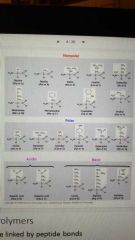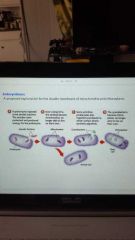![]()
![]()
![]()
Use LEFT and RIGHT arrow keys to navigate between flashcards;
Use UP and DOWN arrow keys to flip the card;
H to show hint;
A reads text to speech;
59 Cards in this Set
- Front
- Back
|
Amino Acids |
♡All are composed of CHON and two use S ♡Functional groups: Amino and Carboxyl ♡"R" component bound to carbon backbone determines properties ♡Make polypeptides which make proteins |
|
|
R groups |

|
|
|
Protein conformation |
Determines how it functions |
|
|
Primary structure |
The unique sequence of amino acids in a polypeptide (peptide bonds) |
|
|
Secondary structure |
The folding or coiling of the polypeptide into a repeating configuration (hydrogen bonding) |
|
|
Tertiary structure |
Results from interactions between amino acid R groups (disulfide "bridge"; hydrogen bonding, hydrophobic interactions, ionic bonding, van der waals) |
|
|
Quaternary structure |
The overall protein structure that results from the aggregation of 2 or more polypeptide subunits |
|
|
Denaturation |
♡Is when a protein unravels and loses its native configuration ♡May result from changes in pH, temp, salt concentration, chemicals |
|
|
Prion |
♡Protein that can change to a harmful disease causing prion |
|
|
Proteins |
♡Elements: CHONS ♡Monomer: Amino acid ♡Macromolecule: polypeptide ♡Ex: collagen, enzymes, membrane proteins |
|
|
Nucleic Acids |
♡Elements: CHONP ♡Monomer: nucleotide ♡Macromolecule: DNA & RNA ♡Function: Storage of genetic info & protein synthesis |
|
|
Nucleotide |
Made of phosphate group and nucleoside (Made of Pentose sugar and nitrogenous base) |
|
|
DNA vs RNA |
DNA: ♡double-stranded ♡has continuous H bonding ♡sugar: deoxyribose ♡Thymine instead of uracil RNA: ♡single strand ♡only has h bonding where it loops back ♡sugar: ribose ♡has uracil instead of Thymine |
|
|
The plasma membrane |
♡The cell's boundary ♡Selectively permeable ♡Bilayer of phospholipids ♡Held together by hydrophobic interactions |
|
|
Hydrophobic molecules |
♡non polar ♡lipid soluble ♡pass through the membrane rapidly |
|
|
Hydrophillic molecules |
♡polar ♡can not cross the membrane rapidly |
|
|
Cholesterol |
Increases fluidity of membrane |
|
|
Glyco groups |
The cell's identification molecules |
|
|
Proteins function |
♡Transport of molecules ♡Cell recognition ♡Intercellular junctions ♡Enzymatic activity |
|
|
Passive transport |
♡Simultaneously without energy ♡Substances move DOWN their concentration gradient ♡high to low |
|
|
Active transport |
♡Requires energy ♡Substances move UP their concentration gradient ♡low to high |
|
|
Transport protein |
♡Used in both active and passive transport |
|
|
Facilitated diffusion |
Transport proteins speed the movement of molecules across the membrane |
|
|
Osmosis |
NET movement of water |
|
|
Tonicity |
The ability of a solution to cause a cell to gain or lose water |
|
|
Isotonic |
Concentration is the same so no net movement of water |
|
|
Hypertonic |
Concentration of solute is greater than cell so cell will lose water |
|
|
Hypotonic |
Concentration of solute is less than the cell so cell will gain water |
|
|
Tight junctions |
Cells are pressed together, preventing leakage of extracellular fluid |
|
|
Anchoring junction |
Fasten cells together into sheets |
|
|
Gap junction |
Provide cytoplasmic channels between adjacent cells |
|
|
Cell theory |
♡All organisms are made of cells ♡The cell is the fundamental unit of life ♡All cells descend from other cells |
|
|
The ER system |
♡Regulates protein traffic and performs various metabolic processes ♡Includes: 1. Nuclear membrane 2. Endoplasmic reticulum 3. Golgi structures 4. Lysosomes 5. Vacuoles 6. Plasma membrane All of these are connected by vesicles |
|
|
RER |
♡Produces secretory proteins, membrane proteins, and phospholipids |
|
|
SER |
♡Synthesizes lipids (oils, phospholipids, steroid hormones) ♡Metabolizes carbohydrates ♡Stores calcium ♡Detoxifies drugs, poisons |
|
|
Golgi Body |
♡Receives stuff from Cis side from RER, modifies the products, makes certain macromolecules, and sends stuff from trans side |
|
|
What can and can't get in through membrane |
Can: ♡Small uncharged molecules ♡Lipid soluble substances Can't: ♡Water-soluble substances ♡Ions |
|
|
Membrane proteins |
1. Channels or transporters (move molecules) 2. Receptors (recognize chemicals) 3. Glycoproteins (identify cell type) 4. Enzymes (catalyze production of substances) |
|
|
Lysosomes |
♡Digest/recycle all kinds of macro ♡Carry out phagocytosis |
|
|
Tay Sachs disease |
♡Lysosomal disorder that causes build up of lipid molecules in neurons |
|
|
Vacuoles |
♡Food vacuoles (formed by phagocytosis) ♡Contractile vacuoles (pump excess water out) ♡Large central vacuoles (storage in plant cells) ♡A plant or fungal cell may have one or several vacuoles |
|
|
The Nucleus |
Contains most of the cell's genes |
|
|
The nuclear envelope |
Encloses the nucleus and is a double membrane |
|
|
Nucleolus |
Direct synthesis of RNA and forms ribosomes |
|
|
Ribosomes |
♡Particles made of RNA and protein ♡Carry out protein synthesis free in the cytosol and attached the ER |
|
|
Bacteria-like organelles |
♡Mitochondria ♡Chloroplast ♡Derived from symbiotic bacteria ♡Similar in size and shape to prokaryotes ♡Have their own DNA ♡Circular chromosone like prokaryotic ♡Divide independently of the cell ♡Divide by fission |
|
|
Endosymbiosis |

|
|
|
Cytoskeleton |
♡Mechanical support ♡Anchor organelles ♡Help move substances |
|
|
Cilia |
♡Short and used to move substances outside human cells |
|
|
Flagella |
♡Found on sperm and used to move cells |
|
|
Centrioles |
Play a role in cell division |
|
|
Peroxisome |
♡Similar in size to prosper ♡Contains enzymes and single membrane ♡Contains catalase that decompose hydrogen peroxide which forms from the breakdown of fatty acids ♡Participate in the synthesis of cholesterol and lipids used to make myelin |
|
|
X-ALD |
Disorder that fails to metabolize fatty acids properly which leads to deterioration of myelin sheaths |
|
|
Cell walls |
Made of cellulose in plants and of Chitin in fungi cells |
|
|
Chloroplast |
♡Photosynthesis site ♡Have grana which are stacks of thykaloids ♡Have stroma, the internal fluid |
|
|
Endocytosis |
♡Cell takes in large molecules ♡2 types: 1. Bulk-phase (nonspecific) 2. Receptor-mediated (specific) ♡2 forms: 1. Phagocytosis - cell eating 2. Pinocytosis - cell drinking |
|
|
Exocytosis |
♡Cell taking out material |
|
|
Prokaryotes |
♡Microscopic ♡Unicellular ♡Ubiquitous ♡Genetically very diverse ♡Nutritionally very diverse |
|
|
Bacteria |
♡Have 3 shapes 1. Spherical (cocci) 2. Rod-shaped (bacili) 3. Spiral ♡Have: 1. A capsule (a sticky layer that prevents bacteria from being eaten) 2. Fimbriae and pili (allow cells to "stick" to surroundings) 3. Flagella 4. Endospores (allow bacteria to remain viable in harsh conditions) 5. Cell walls |

